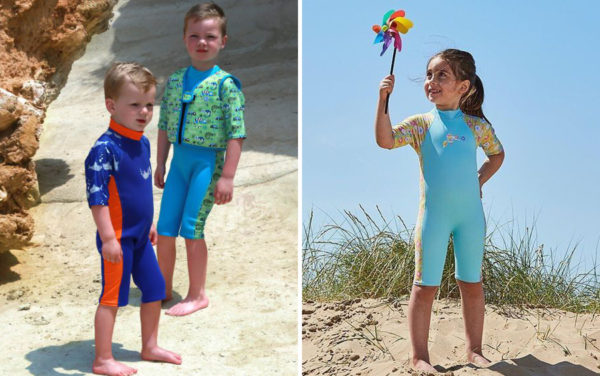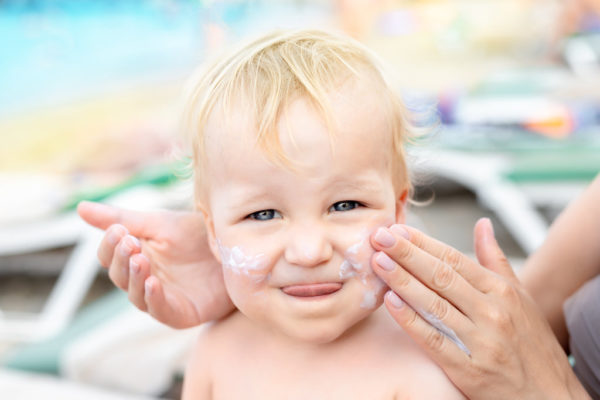Planning a beach getaway with the children on your next holiday? Whether in the UK or abroad, you’ll want to think ahead to ensure the whole family stays safe in the sun and sea.
We know you’re busy and probably looking for a cheat sheet to help you get started, so we’ve prepared one for you below.

A month+ before your holiday
✅ Research the location: Use local websites to look up the facilities at the resort and nearby areas, including the beach. Investigate tide times, toilet blocks and other amenities. You can find useful reviews from other parents on sites like Mumsnet – they’ll tell you what the travel agent left out of the brochure! Also, if you’re holidaying in the UK, visit the RNLI website to look up lifeguarded beaches.
✅ Invest in protective clothing: You’ll need specialist equipment to keep your child safe in the sun and the sea. Here’s your shopping list:
- A floppy hat with a wide brim to provide shade on your child’s face, ears and neck.
- Sunglasses with the British CE mark to protect their eyes from UVA and UVB rays.
- Shoes to protect your child’s feet from hot sand and all the usual beach debris, (e.g. broken shells, rocks and litter). Waterproof jelly shoes are ideal.
- Loose clothing, such as oversized t-shirts, to help your child cover-up in the sun.
- UV Sun and swim suits. We love these suits from SplashAbout.com (pictured below) as they offer SPF 50+ protection and can be worn on the beach and in the sea.

✅ Look into beach equipment: Umbrellas, popup canopies and beach tents will provide much-needed shade on a hot and sunny day. They’ll also help your child spot the family base from the shore.
1-2 weeks before your holiday
✅ Prepare a first aid kit: Children are clumsy and beaches present lots of potential risks. From cuts and bruises to wasp stings. Get prepared during your next supermarket shop. Pick up the following extras to pack in your beach bag:
- Cotton balls
- Scissors
- Tweezers
- Calamine lotion
- Antiseptic
- Instant ice packs
- Plasters
- Dressings
- Insect repellent
- Aftersun
✅ Stock up on sun cream: You’ll need to buy a few tubs of sun cream. Look for formulas that are factor 15+ and that protect from both UVA and UVB rays. Some brands sell sunscreens aimed at children that are easier to apply. They often have a higher SPF rating and will provide more protection too. Invest in waterproof creams if your child intends to spend lots of time in the sea. And don’t forget to buy lip balm with SPF protection.
✅ Brush up on sea safety: It’s time for a quick refresher on sea safety. Read up on how to spot a rip current and what to do if you are caught in one, learn how to avoid getting cut off by the tide and understand wave safety.

On the beach
✅ Slap on the sun cream: Hooray! You’ve made it to the beach. Now you’re here, your first job is to apply sun cream to your child. Put it on all the exposed parts of their skin. Pay particular attention to the ears, feet and the back of the hands (these are often forgotten).
✅ Look for shade: The sun is strongest between 11am and 3pm. During these hours, try and encourage your child to play in shaded spots.
✅ Be aware of the water conditions: It goes without saying, but keep a watchful eye on your children as they swim in the sea. Even older children that are confident swimmers can find themselves in trouble unexpectedly. If you’re on a lifeguarded beach, familiarise yourself with the flags and their meanings especially if you are abroad. You can ask the lifeguard if you’re unsure or visit the RNLI website for more details if you’re in the UK. And finally, consider banning inflatables from the water. They’re one of the most common reasons for lifeboat rescues. They pose a huge risk as they can be easily swept out to sea.

Further reading –
We used the following trusted resources to help compile this sun and sea safety list. We recommend you read their guides for further information:
NHS – sunscreen sun safety
NHS – sun safety for children
RNLI – advice on bringing inflatables to the beach
RNLI – know the risks (rip currents, tides, waves, etc)
Met Office – beach safety tips
UK Government – Keeping safe at the coast: beach safety advice
this is a collaborative post
